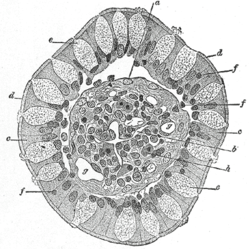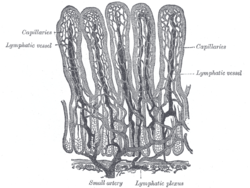| Lacteal | |
|---|---|
 Transverse section of a villus, from the human intestine. X 350. a. Basement membrane, here somewhat shrunken away from the epithelium. b. Lacteal. c. Columnar epithelium. d. Its striated border. e. Goblet cells. f. Leucocytes in epithelium. f’. Leucocytes below epithelium. g. Bloodvessels. h. Muscle cells cut across. | |
 Villi of small intestine, showing bloodvessels and lymphatic vessels. | |
| Anatomical terminology |
A lacteal is a lymphatic capillary that absorbs dietary fats in the villi of the small intestine.
Triglycerides are emulsified by bile and hydrolyzed by the enzyme lipase, resulting in a mixture of fatty acids, di- and monoglycerides.[1] These then pass from the intestinal lumen into the enterocyte, where they are re-esterified to form triglyceride. The triglyceride is then combined with phospholipids, cholesterol ester, and apolipoprotein B48 to form chylomicrons. These chylomicrons then pass into the lacteals, forming a milky substance known as chyle. The lacteals merge to form larger lymphatic vessels that transport the chyle to the thoracic duct where it is emptied into the bloodstream at the subclavian vein.[2][3]
At this point, the fats are in the bloodstream in the form of chylomicrons. Once in the blood, chylomicrons are subject to delipidation by lipoprotein lipase. Eventually, enough lipid has been lost and additional apolipoproteins gained, that the resulting particle (now referred to as a chylomicron remnant) can be taken up by the liver. From the liver, the fat released from chylomicron remnants can be re-exported to the blood as the triglyceride component of very low-density lipoproteins. Very low-density lipoproteins are also subject to delipidation by vascular lipoprotein lipase, and deliver fats to tissues throughout the body. In particular, the released fatty acids can be stored in adipose cells as triglycerides. As triglycerides are lost from very low-density lipoproteins, the lipoprotein particles become smaller and denser (since protein is denser than lipid) and ultimately become low-density lipoproteins. LDL particles are highly atherogenic.[4]
In contrast to any other route of absorption from the small intestine, the lymphatic system avoids first pass metabolism.
YouTube Encyclopedic
-
1/3Views:103 40725 992144 315
-
Lipid and protein transport in the lymphatic system | NCLEX-RN | Khan Academy
-
Lymphatic system 4, Chyle system
-
Small intestine and food absorption | Physiology | Biology | FuseSchool
Transcription
We've already talked about two purposes of the lymphatic system. The first was to bring the fluid that was squeezed out of the capillaries back into the blood, and the second was to help out the immune system. But there's one more. There's a third. And that's what we're going to talk about in this video. So let's look at a piece of the small intestine. Now, obviously the small intestine carries bits of food that your body wants to absorb and use for energy. So one of the most important elements of that food is little glucose molecules, which are absorbed and are used as the primary source of energy for the body. So actually, since it'll be helpful for us, let's at least make this two dimensional. So let's look at some cells here of the small intestine. So these are cells lining the small intestine. And the way that glucose is actually absorbed by your body is that it's pumped into these cells here, in the cells lining the intestine. And then it's pumped out of them. And then once it's here in this space, it's able to diffuse into capillaries which are nearby. So it'll diffuse into the capillaries, and once it's there can go and spread out over the whole body and feed various cells. But glucose is not the only thing which needs to be absorbed in your small intestine, and actually another compound is fat. So fatty acids which are floating around in your small intestine need to be absorbed as well. And the structure of these things, to remind you, looks something like this. You've got this carboxylic acid group attached to a long chain of carbons. Now, like glucose, these guys are taken up by these cells in the intestine. But when they're put out by those cells, they no longer look like this. By the time they're put out, they're packaged into these actually rather large spherical objects which have a weird name. It's chylomicron. So they're packaged into these spherical things called chylomicrons, and these chylomicrons are useful for holding a lot of these fats together. But they have a problem, which is that chylomicrons, as you might guess, are too big to diffuse into the capillaries. So they can't do that. But you don't want to have chylomicrons just accumulating here in your intestine. You want to spread them out to the body where they're needed, and so that's where our good friend the lymphatic system comes in. So we have these lymphatic vessels nearby that are much easier to enter than the capillaries, and the chylomicrons able to diffuse into these vessels and be transported through the lymphatic system and eventually emptied into the blood circulation so that they can spread throughout the body. Because this is such an important processes, these lymphatic vessels in your small intestine are given a special name. And that name is lacteal. So the lymphatic vessels in your small intestine are known as lacteals, and those are the ones that take up your fats in the form of chylomicrons. So here we have our third important function of the lymphatic system, which is to transport things which didn't originally come from the blood, to transport them into the blood. And we can sort of generalize it a little bit and say that maybe a little further away from the small intestine somewhere else you have some cells that are hanging out. And actually, there are some other things which your body might want to put into lymphatic circulation. So you may have some cells here or elsewhere in the body that are producing maybe some proteins like hormones or maybe some waste products. And in some cases those proteins might have trouble getting into the capillaries, and these waste products also might have trouble. But you want these things to get into the blood because, for example, for hormones, you want them to be able to travel throughout the body and have their effects on the tissues that they're supposed to effect. And for waste products, you want them to be able to get into the blood and eventually get to the liver where they might be broken down or to the kidney where they can be excreted. So in those cases, you have this secondary system of getting these things into blood circulation through the lymphatic vessels. So these are proteins and wastes. And the reason that we're talking about these at the same time as chylomicrons is because these are all things that don't actually come from the blood, but we want to put them in the blood. And we can't do it directly, so we put them into lymphatic circulation first. So, now that we've learned about the third purpose of the lymphatic system, it might be a good time to review all three purposes at once. So why don't you pause the video and see if you can remind yourself of all three. Otherwise, I'll go ahead and describe them here. So the first purpose of the lymphatic system-- let's draw another lymphatic vessel here. The first purpose was to collect all the fluid which was forced out of the capillaries by the high pressure that's present in the blood, to gather all that fluid and bring it back into blood circulation via the lymphatic vessels so that you don't have too much fluid accumulating here in the tissue. So that's the first purpose. This is just fluid with maybe some small plasma proteins, but not with any red blood cells or anything like that. The second purpose had to do mostly with infection. So if you have some bacteria infecting some tissue in your body, the lymphatic system basically offers a way to bring those bacteria to the attention of your immune system. And they do that by basically taking them up and bringing them to the nearest lymph node. So that's a lymph node, and that is where your B cells and T cells are hanging out. So that's the second purpose right there, the second purpose of your lymphatic system. And the third purpose, of course, is what we discussed today. It's transporting other things, such as chylomicrons or other proteins or wastes, transporting them into the blood when they have trouble simply getting into capillaries the normal way.
References
- ^ Young, Barbara; Wheater, Paul, eds. (2006). Wheater's functional histology: a text and colour atlas. Elsevier Health Sciences. p. 279. ISBN 978-0-443-06850-8.
- ^ Newsholme, Eric; Leech, Anthony (2009). Functional Biochemistry in Health and Disease. John Wiley & Sons. p. 79. ISBN 978-0-471-98820-5.
- ^ Montague, Susan E.; et al., eds. (2005). Physiology for nursing practice. Elsevier. p. 502. ISBN 978-0-7020-2676-8.
- ^ Carmena, Rafael; Duriez, Patrick; Fruchart, Jean-Charles (2004-06-15). "Atherogenic Lipoprotein Particles in Atherosclerosis". Circulation. 109 (23_suppl_1): III–2. doi:10.1161/01.CIR.0000131511.50734.44. PMID 15198959. S2CID 15994547.
External links
- Histology image: 11705ooa – Histology Learning System at Boston University - "117. Digestive System: Alimentary Canal jejunum, central lacteals "
